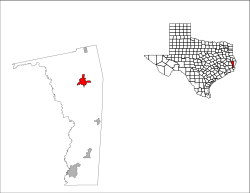Jasper, Texas
| Jasper, Texas | |
|---|---|

Downtown Jasper from corner of Lamar and Zavalla
|
|
| Motto: "Jewel Of The Forest" | |
 Location of Jasper, Texas |
|
| Coordinates: 30°55′20″N 93°59′56″W / 30.92222°N 93.99889°WCoordinates: 30°55′20″N 93°59′56″W / 30.92222°N 93.99889°W | |
| Country | |
| State |
|
| County | Jasper |
| Government | |
| • Type | Council-Manager |
| • City Council | Mayor Randy Sayers Mayor Pro-Tem Raymond Hopson (District 4) Alton Scott (District 1) Randy M. Sayers (District 2) Hazel Johnson (District 3) Mitch McMillon (District 5 - At Large) |
| • City Manager | Denise Kelley (acting) |
| Area | |
| • Total | 10.4 sq mi (26.9 km2) |
| • Land | 10.3 sq mi (26.8 km2) |
| • Water | 0.1 sq mi (0.2 km2) |
| Elevation | 203 ft (62 m) |
| Population (2000) | |
| • Total | 8,247 |
| • Density | 797.4/sq mi (307.9/km2) |
| Time zone | Central (CST) (UTC−6) |
| • Summer (DST) | CDT (UTC−5) |
| ZIP code | 75951 |
| Area code(s) | 409 |
| FIPS code | 48-37420 |
| GNIS feature ID | 1360162 |
| Website | jaspertx.org |
Jasper is a city and the county seat of Jasper County, Texas, in the United States. The population was 8,247 at the 2000 census and 7,590 at the 2010 census. Jasper is situated in the Deep East Texas subregion, about 130 miles (210 km) northeast of Houston. Jasper (the "Butterfly Capital of Texas") holds an annual Butterfly Festival the first Saturday in October to celebrate the migration of the monarch butterflies.
The area, which was then part of Mexican Texas, was settled around 1824 by John Bevil. Thirty families occupied the settlement as early as 1830, when it was known as Snow River or Bevil's Settlement after John R. Bevil, a hero of the American Revolution.
In 1835, the town was renamed after William Jasper, a war hero from the American Revolution, who was killed attempting to plant the American flag at the storming of Savannah in 1779. Jasper was one of the 23 original counties when the Republic of Texas was created in 1836. Jasper became the county seat in 1844, becoming part of the United States with the Texas annexation in 1845.
During the Civil War, the town housed a Confederate quartermaster depot and served as a major center for Confederate communication, transportation, and supply. Jasper was a Confederate Army headquarters for a nine-county area. Following the war, Union troops led by General George Custer occupied Jasper, camping in the town square. The only known soldier of the American Revolution to be buried in Texas was Jasper resident Stephen Williams, in whose honor a marker has been placed on the courthouse lawn.
Educational institutions included the Jasper Male and Female High School, which operated until 1878, when it became the Southeast Texas Male and Female College, and Jasper Collegiate Institute, which operated from 1851 until 1874. The population declined to 360 in 1870, reflecting the hardships of the Civil War, but by 1885 had risen to 1,000.
...
Wikipedia
